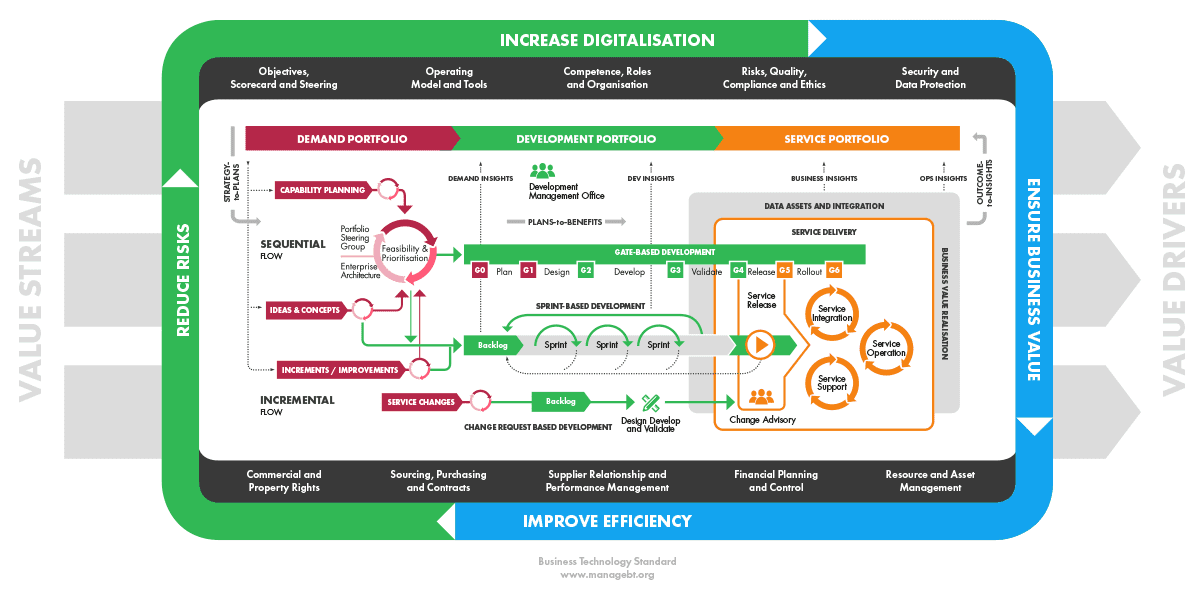The business technology operating model is a high-level illustration on how a company can create business value with information technology. It presents the company’s strategic excellence topics, value streams and business technology value adding elements.
The target of the business technology operating model is to ensure that the technology management contributes to business excellence. The target is achieved by having continuous focus on attempts to increase digitalisation efforts, ensure business benefits, improve efficiency and reduce risk.
The business technology operating model captures business value to parallel value streams. The value streams reflect the organisation’s key activities, and their purpose can be illustrated with three examples as shown in the picture below.
The customer interfacing technology focuses on agility and new digital frontline solutions, whereas the business process technology focuses on enterprise-level and backbone solutions. Operational technology value stream focuses on specific solutions that are valuable for certain geographical regions or business domains only.
Figure 3.2.1 Value creating streams
The business technology operating model consists of five disciplines:
Strategy and Governance discipline sets the guidelines and manages the whole business technology function. It defines the organisational structure and ensures that the business technology strategy and operating model support the business objectives. Strategy and governance discipline is led by the Business Technology Governance Officer (BTGO).
Demand discipline captures the business needs and requirements and turns development initiatives into operational actions. Demand discipline provides content to portfolios, plans roadmaps and facilitates the creation of innovations and concepts as well as analysis of feasibility. Demand discipline is led by the Business Information Officers (BIO), Service Owners and Chief Digital Officer (CDO).
Development discipline comprises of building new solutions and improving current capabilities. It includes designing and developing business initiatives and is responsible for building operational readiness and working solutions. Development discipline is led by the Business Technology Development Officer (BTDO) together with project and product owners.
Services discipline runs business services and provides service support. It is responsible for business continuity and is led by the Business Technology Operations Officer (BTOO).
Sourcing and Optimisation discipline ensures that the company has the services that best fit its business purposes. It constantly optimises the delivery ecosystem in order to provide services cost-efficiently and appropriately. Sourcing and optimisation are led by the Business Technology Management Officer (BTMO), Service Owner and Sourcing Lead who have the responsibility on end-to-end service excellence.
The five disciplines of the business technology operating model support the realisation of the company’s business targets by enabling the following:
Multi-speed: Combining the agility of digitalisation with the need for scalability and reliability in enterprise solutions. The business requirements for both agility and governance are met through two separate value flows: incremental and sequential. By selecting the best-fit partners and solutions, the business technology function can be agile and fast in realising the expectations with a fit for purpose development approach.
Clarity with unified ways of working: Building a way of working that is understood and adopted by all relevant stakeholders, including business executives and business technology partners. Creating a common culture of working through common language, identity and unified roles, unified practices, transparency and well-communicated decision-making models, will lead to reduced risks and improved efficiency.
Efficiency: Using tools that support the implementation of the operating model and enable industrial-like efficiency such as process automation. The tools should reflect the agreed roles and responsibilities, support practices and guide the organisation in the right direction. In order to improve efficiency and transparency, the tools should be deployed to innovation, project, and service management as well as resource and cost management.
The business technology operating model splits the value creation in three value creation phases.
Figure 3.2.2 Value creating phases
Demand | Plan phase captures the business demand. It includes planning and concept design and is responsible for introducing new initiatives into portfolio and roadmap.
Development | Build phase develops the business intiatives into products, solutions and services. It ensures business commitment to development requests in portfolio and backlog. It is resposible for the implementation and the realisation of business benefits.
Services | Run phase operate services. It ensures that service release, delivery and retirement doesn’t compromise business continuty or service experience.
There are two different approaches on how to ensure the delivery of the value: sequential and incremental.
Figure 3.2.3 Sequential and incremental value creation
Sequential approach considers development initiatives based on a business case.
The prioritisation and optimisation decisions are made based on an unified business case model which enables full guidance and control, especially in the transition phases: from demand to development and from development to services. The sequential approach fits well with enterprise development needs where the control and coordination of synergies and priorities is prevailing over speed and agility.
Incremental approach aims to ensure the fastest development cycles.
The prioritisation and optimisation decisions are made within a specific focus area to ensure a short time to market. The incremental approach fits well with digital and product development where the speed and agility prevails over centralised decision-making and coordination of resources.
The business technology operating model should be connected to day-to-day operations with appropriate tools, such as the following:
